written by Laurie Tom
July means the start of the summer anime season, so I’m taking a look at most of the new shows that have caught my interest. Typically I watch 2-3 series as they air so I don’t intend to finish all of these, and I’m still watching last season’s M3: the dark metal, leaving less room for newcomers.
Aldnoah.Zero
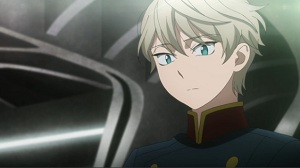 Why I Watched It: Someone favorably compared it to Crest of the Stars, one of the most underrated anime space operas ever, and I really wanted to watch something with a strong sf bent.
Why I Watched It: Someone favorably compared it to Crest of the Stars, one of the most underrated anime space operas ever, and I really wanted to watch something with a strong sf bent.
What I Thought: Definitely one of the most interesting premises this season! In an alternate timeline, the Apollo 17 mission discovered a Hyper Gate to Mars on the moon, and humanity’s mucking around there resulted in the Martian Vers civilization (which is human) revealing itself. By the time the year 2014 rolls around, there is a tentative peace between the two sides, but that is broken in short order when a terrorist act on Earth provokes the technologically superior Vers into attacking. Pleasantly enough, it looks like there might be a subplot involving one of the older (read: non-teenage) characters and a Terran/Martian conflict that happened in 1999. Aldnoah.Zero is the only series this season that had me at the edge of my seat as the first episode closed.
Verdict: I will be watching it. It looks like there will be heroes and villains on both sides of the conflict and I’m particularly drawn to the character Slaine, who seems to be a Terran living and working among the Vers. For people who love worldbuilding, there is a ton of backstory in this first episode, and it never feels like a giant info dump.
Where to find stream: Crunchyroll, Daisuki, and Hulu.
Blue Spring Ride
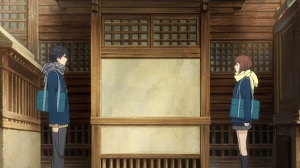 Why I Watched It: The preview clips tapped into my memories of middle school and high school. A girl has a crush on a boy in middle school who moves away and then returns in high school, but they can’t pick up where they left off.
Why I Watched It: The preview clips tapped into my memories of middle school and high school. A girl has a crush on a boy in middle school who moves away and then returns in high school, but they can’t pick up where they left off.
What I Thought: Oddly enough, the more fanciful part of Futaba Yoshioka’s life is the one I relate to, with the crush moving away and coming back again. But I suspect the number of people who can claim similar experiences is relatively low. For everyone else, this is a story about the girl who was super popular with boys in middle school, hated it because it alienated her from all the girls, and entered high school determined to look like an unwomanly slouch so guys would stop hitting on her and she could have female friends. Futuba largely succeeds, though it’s also clear that she is not being herself, so much as exhibiting these behaviors just to ward off guys. The friends she gains too†� yeesh†� she could do better. When Futaba is accused of stealing from the school store, her friends don’t even take her side. Her love interest, Kou Mabuchi, seems like a decent enough romantic lead. Futaba thinks he’s being a bit of a jerk, but I think it’s more that he’s trying not to jump into a relationship based on memories in middle school.
Verdict: I will probably be watching it. (It’s actually a toss up between this and the next show on the list.) Being based on a romance manga it’s expected the two main characters will eventually get back together again, making it a predictable watch, but I found this to be one of the more moving romances.
Where to find stream: Crunchyroll
Nobunaga Concerto
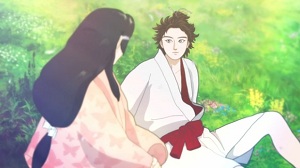 Why I Watched It: Holey moley! I thought this would get passed by all the western simulcasts due to its non-standard art style and focus on Japanese history, but I’ve been proven wrong. I was interested because the premise is that a modern day high school student goes back in time and becomes Nobunaga Oda, the famous warlord who starts the campaign to unite Japan, and the art style is clearly period influenced.
Why I Watched It: Holey moley! I thought this would get passed by all the western simulcasts due to its non-standard art style and focus on Japanese history, but I’ve been proven wrong. I was interested because the premise is that a modern day high school student goes back in time and becomes Nobunaga Oda, the famous warlord who starts the campaign to unite Japan, and the art style is clearly period influenced.
What I Thought: Better than I thought! The show does require some suspension of disbelief, mostly in two forms: 1) No one suspects that Nobunaga’s recent strange behavior is due to the fact they’re looking at an imposter that physically resembles him and 2) Saburo accepts everything that’s happened to him real fast (being stuck in the Sengoku era, taking Nobunaga’s place in history, etc). The fun part though is that Saburo still intends to do things his way while making sure that history stays the course. I’m a little concerned that the real Nobunaga ditches his life and responsibilities so easily though. Is he ever going to come back on the show?
Verdict: I really want to say I’ll be watching, but I can’t guarantee I’ll have the bandwidth. I will probably end up dropping this or Blue Spring Ride depending on how later episodes pan out.
Where to find stream: Crunchyroll
Persona 4: the Golden Animation
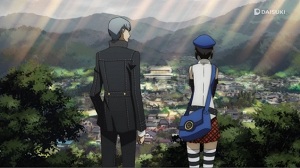 Why I Watched It: Revisiting Persona 4 is like seeing an old friend. It’s impossible not to feel nostalgia for what had been wonderful times, yet I can’t help wondering if things will be the same again. Persona 4: the Animation aired just a scant three years ago and is still one of my favorite series. Can they really make it any better?
Why I Watched It: Revisiting Persona 4 is like seeing an old friend. It’s impossible not to feel nostalgia for what had been wonderful times, yet I can’t help wondering if things will be the same again. Persona 4: the Animation aired just a scant three years ago and is still one of my favorite series. Can they really make it any better?
What I Thought: The show is clearly geared towards people already familiar with Persona 4 as the opening showcases all the main characters (and surprisingly a lot of the minor ones!) as they start the school year. The first third of the episode is beautiful. Those credits, that music! It’s exactly what Persona should be. Then the rest of the episode gets awkward fast, probably because it’s trying not to redo the series from three years ago, but certain scenes have to happen. A lot of information necessary to non-fans is skipped, and the key fight scene in the first episode seemed like it was trying painfully hard to one-up its predecessor, with the end result backfiring and pushing my suspension of disbelief.
Verdict: Since Persona 4: the Golden Animation is based off of Persona 4: The Golden the game (the extended cut of Persona 4 containing new events, new subplots, and a new character) I might come back to it as some point as watching an anime series is faster than playing an RPG, but I’m sad to say this is going on the backburner. The first Persona 4 anime series is still excellent and would serve as a better introduction for people who haven’t played the game.
Where to find stream: Crunchyroll, Daisuki, and Hulu.
Sailor Moon Crystal
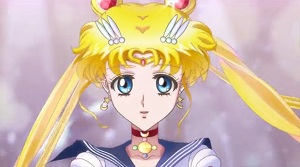 Why I Watched It: Any anime fan over a certain age will remember the debut of the original Sailor Moon on North American TV back in 1995. It had a lot of filler since the manga ran concurrent to the TV show, and for American audiences there was a boatload of editing and censorship. Sailor Moon Crystal is a fresh adaptation of the original manga (presumably with no filler) and will not be edited for American audiences this time.
Why I Watched It: Any anime fan over a certain age will remember the debut of the original Sailor Moon on North American TV back in 1995. It had a lot of filler since the manga ran concurrent to the TV show, and for American audiences there was a boatload of editing and censorship. Sailor Moon Crystal is a fresh adaptation of the original manga (presumably with no filler) and will not be edited for American audiences this time.
What I Thought: I’m not sure the new art style really works for me, even though it’s closer to the original manga. It’s been a long time since I watched the original series, and I was never the biggest fan, but the update has a pretty fine first episode. Usagi has always been a reluctant heroine, and that hasn’t changed. She’s still a terrible student, a clutz, and goof-off, but will run to help a friend no matter what. Even though the plot of the first episode is familiar, it feels like we’re moving at a faster pace this time around (not a bad thing), and I like that snapshots of her previous life are introduced earlier. I have to admit that parts of the opening credits made the little girl in me squee and I like the new feminist lyrics to the opening song where they declare they don’t need to rely on men to help them.
Verdict: I probably will not watch this on simulcast since I’m already familiar with the show, but I’m pretty sure I’ll catch up with it another time since I would like to see a more faithful adaptation than what we got in the 90s.
Where to find stream: Crunchyroll and Hulu
Sword Art Online II
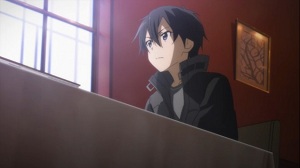 Why I Watched It: The first half of the first Sword Art Online series was gamer anime heaven for anyone who has ever played an MMORPG. The second half†� not so much and is best skipped and erased from existence. But the first half was so good that I’m willing to give the second series a chance.
Why I Watched It: The first half of the first Sword Art Online series was gamer anime heaven for anyone who has ever played an MMORPG. The second half†� not so much and is best skipped and erased from existence. But the first half was so good that I’m willing to give the second series a chance.
What I Thought: It feels a little forced, trying to find a reason for Kirito to keep logging into new games when he should be among the last people who would ever want to play an MMO again, but the opening was still better than I thought it would be. The mystery is intriguing. Someone is assassinating top players in the virtual reality game Gun Gale Online and when they die online, their hearts stop in the real world, which should not be possible, and there is no brain damage done (people were killed through their VR helmets in the first SAO). It doesn’t quite make sense that the government would ask a teenager to log in for the investigation, but they do and Kirito reluctantly agrees.
Verdict: I’m fence-sitting on this one. It has promise, but I’m really concerned the writing will drop off as it did in the second story arc and I’m afraid that Asuna, the best female character of the first series, is going to be sidelined as the sit-and-watch girlfriend. The opening episode is just good when I needed it to be excellent.
Where to find stream: Crunchyroll and Daisuki
Terror in Resonance
 Why I Watched It: Good pre-release buzz about a series involving two high school terrorists with a plan to bring Japan to its knees. Obvious question is: Why?
Why I Watched It: Good pre-release buzz about a series involving two high school terrorists with a plan to bring Japan to its knees. Obvious question is: Why?
What I Thought: I suspect this will probably be a fairly popular show, the animation is good and the premise unusual, but it’s just not my cup of tea. While I don’t find the conceit behind high school aged terrorists unbelievable, there are a couple of things that happen towards the end of the first episode that stretch my believability (and being a dramatic work set in the real world, it really needs that believability). I also dislike that bullied girl Lisa is essentially blackmailed into becoming an accomplice to her mysterious new terrorist classmates. There’s some backstory behind the two boys escaping an institution of some kind and it was a rough time for them, but the show makes it pretty clear that they are not good people.
Verdict: This is one of those shows that I might come back to later after it’s been fully released and I hear more about it. Right now I can’t relate to any of the characters except Lisa, and I’m not sure I want to relate to anyone else.
Where to find stream: Funimation and Hulu
Tokyo Ghoul
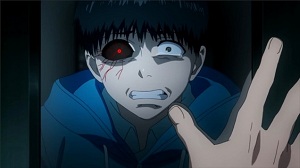 Why I Watched It: I like stories where good characters have to grapple with terrible choices, and it doesn’t get much more awful than suddenly discovering that you’ve turned into a ghoul with cannibalistic urges to eat other humans.
Why I Watched It: I like stories where good characters have to grapple with terrible choices, and it doesn’t get much more awful than suddenly discovering that you’ve turned into a ghoul with cannibalistic urges to eat other humans.
What I Thought: It’s not quite as gory as I feared it might be, which is a relief. You might know that’s a half-chewed dead body in the darkness, but the show doesn’t come out and show it. What I’m surprised about is that ghouls are public knowledge in this world so people are aware of them and there seems to be a limited sort of understanding between regular humans and them. Unlike getting turned in a vampire and hungering for blood, getting turned into a ghoul and hungering for flesh is not sexy, and Tokyo Ghoul takes pains to show main character Kaneki trying to deal with his new condition when he’s both completely ignorant of how ghoul society works, and is repulsed by the thought of eating human flesh.
Verdict: I will be watching it. But it’s definitely not for everyone. It’s a dark show and I’m pretty sure that Kaneki will end up sliding down the slippery slope sooner or later. Eating humans does not appear to be optional for ghouls. Human food causes him to throw up.
Where to find stream: Funimation and Hulu
 Laurie Tom is a fantasy and science fiction writer based in southern California. Since she was a kid she has considered books, video games, and anime in roughly equal portions to be her primary source of entertainment. Laurie is a previous grand prize winner of Writers of the Future and since then her work has been published in venues such as Galaxy’s Edge, Crossed Genres, and Solaris Rising: The New Solaris Book of Science Fiction.
Laurie Tom is a fantasy and science fiction writer based in southern California. Since she was a kid she has considered books, video games, and anime in roughly equal portions to be her primary source of entertainment. Laurie is a previous grand prize winner of Writers of the Future and since then her work has been published in venues such as Galaxy’s Edge, Crossed Genres, and Solaris Rising: The New Solaris Book of Science Fiction.
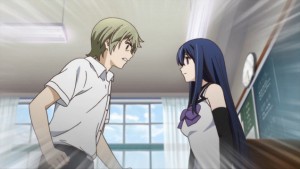 Brynhildr in the Darkness tried very hard to make me stop watching it, probably more so than any other series I can think of in recent years. On the one hand it has a smart and likeable main character who manages to pull off being a high school student protagonist without coming off as unrealistic wish fulfillment. Ryota is definitely not that powerful and works within the limitations of being an ordinary human caught up protecting artificial witches from the secret organization that created them.
Brynhildr in the Darkness tried very hard to make me stop watching it, probably more so than any other series I can think of in recent years. On the one hand it has a smart and likeable main character who manages to pull off being a high school student protagonist without coming off as unrealistic wish fulfillment. Ryota is definitely not that powerful and works within the limitations of being an ordinary human caught up protecting artificial witches from the secret organization that created them. Laurie Tom is a fantasy and science fiction writer based in southern California. Since she was a kid she has considered books, video games, and anime in roughly equal portions to be her primary source of entertainment. Laurie is a previous grand prize winner of Writers of the Future and since then her work has been published in Galaxy’s Edge, Penumbra, and Solaris Rising: The New Solaris Book of Science Fiction.
Laurie Tom is a fantasy and science fiction writer based in southern California. Since she was a kid she has considered books, video games, and anime in roughly equal portions to be her primary source of entertainment. Laurie is a previous grand prize winner of Writers of the Future and since then her work has been published in Galaxy’s Edge, Penumbra, and Solaris Rising: The New Solaris Book of Science Fiction.
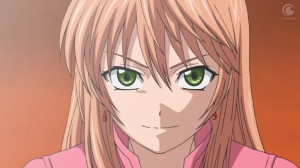 The World is Still Beautiful is based off an ongoing shoujo (girls) manga of the same name. Teenage Princess Nike comes from the small and relatively powerless Duchy of Rain, and in recent years a furious warlord known as the Sun King has conquered most of the known world. In exchange for leaving the Duchy of Rain alone, he asks for one of their princesses to be sent to him as a bride.
The World is Still Beautiful is based off an ongoing shoujo (girls) manga of the same name. Teenage Princess Nike comes from the small and relatively powerless Duchy of Rain, and in recent years a furious warlord known as the Sun King has conquered most of the known world. In exchange for leaving the Duchy of Rain alone, he asks for one of their princesses to be sent to him as a bride.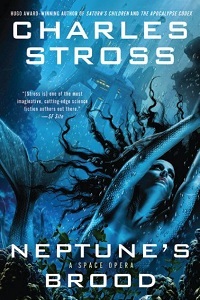
 Why I Watched It: Someone favorably compared it to Crest of the Stars, one of the most underrated anime space operas ever, and I really wanted to watch something with a strong sf bent.
Why I Watched It: Someone favorably compared it to Crest of the Stars, one of the most underrated anime space operas ever, and I really wanted to watch something with a strong sf bent. Why I Watched It: The preview clips tapped into my memories of middle school and high school. A girl has a crush on a boy in middle school who moves away and then returns in high school, but they can’t pick up where they left off.
Why I Watched It: The preview clips tapped into my memories of middle school and high school. A girl has a crush on a boy in middle school who moves away and then returns in high school, but they can’t pick up where they left off. Why I Watched It: Holey moley! I thought this would get passed by all the western simulcasts due to its non-standard art style and focus on Japanese history, but I’ve been proven wrong. I was interested because the premise is that a modern day high school student goes back in time and becomes Nobunaga Oda, the famous warlord who starts the campaign to unite Japan, and the art style is clearly period influenced.
Why I Watched It: Holey moley! I thought this would get passed by all the western simulcasts due to its non-standard art style and focus on Japanese history, but I’ve been proven wrong. I was interested because the premise is that a modern day high school student goes back in time and becomes Nobunaga Oda, the famous warlord who starts the campaign to unite Japan, and the art style is clearly period influenced. Why I Watched It: Revisiting Persona 4 is like seeing an old friend. It’s impossible not to feel nostalgia for what had been wonderful times, yet I can’t help wondering if things will be the same again. Persona 4: the Animation aired just a scant three years ago and is still one of my favorite series. Can they really make it any better?
Why I Watched It: Revisiting Persona 4 is like seeing an old friend. It’s impossible not to feel nostalgia for what had been wonderful times, yet I can’t help wondering if things will be the same again. Persona 4: the Animation aired just a scant three years ago and is still one of my favorite series. Can they really make it any better? Why I Watched It: Any anime fan over a certain age will remember the debut of the original Sailor Moon on North American TV back in 1995. It had a lot of filler since the manga ran concurrent to the TV show, and for American audiences there was a boatload of editing and censorship. Sailor Moon Crystal is a fresh adaptation of the original manga (presumably with no filler) and will not be edited for American audiences this time.
Why I Watched It: Any anime fan over a certain age will remember the debut of the original Sailor Moon on North American TV back in 1995. It had a lot of filler since the manga ran concurrent to the TV show, and for American audiences there was a boatload of editing and censorship. Sailor Moon Crystal is a fresh adaptation of the original manga (presumably with no filler) and will not be edited for American audiences this time. Why I Watched It: The first half of the first Sword Art Online series was gamer anime heaven for anyone who has ever played an MMORPG. The second half†� not so much and is best skipped and erased from existence. But the first half was so good that I’m willing to give the second series a chance.
Why I Watched It: The first half of the first Sword Art Online series was gamer anime heaven for anyone who has ever played an MMORPG. The second half†� not so much and is best skipped and erased from existence. But the first half was so good that I’m willing to give the second series a chance. Why I Watched It: Good pre-release buzz about a series involving two high school terrorists with a plan to bring Japan to its knees. Obvious question is: Why?
Why I Watched It: Good pre-release buzz about a series involving two high school terrorists with a plan to bring Japan to its knees. Obvious question is: Why? Why I Watched It: I like stories where good characters have to grapple with terrible choices, and it doesn’t get much more awful than suddenly discovering that you’ve turned into a ghoul with cannibalistic urges to eat other humans.
Why I Watched It: I like stories where good characters have to grapple with terrible choices, and it doesn’t get much more awful than suddenly discovering that you’ve turned into a ghoul with cannibalistic urges to eat other humans. One Week Friends started off as my one must-watch show of the spring season, despite having only the barest of speculative elements (in that Kaori’s malady is not a real world condition). Though the rest of the series never again hits the high of the first episode, it remains an enjoyable watch throughout.
One Week Friends started off as my one must-watch show of the spring season, despite having only the barest of speculative elements (in that Kaori’s malady is not a real world condition). Though the rest of the series never again hits the high of the first episode, it remains an enjoyable watch throughout. Warbound is the third book in Larry Correia’s Grimnoir Chronicles, preceded by Hard Magic and Spellbound. It takes place in a fantasy alternate-history 1930s. The branch in history took place in the 1850s when a magical force called The Power chose some subset of humanity to draw on its magical resources and become superpowered to give them the power to fight against the monstrous Pathfinder that eats magic and twists that magic to its own devices. And the Pathfinder itself is only an advance scout of its even more powerful master.
Warbound is the third book in Larry Correia’s Grimnoir Chronicles, preceded by Hard Magic and Spellbound. It takes place in a fantasy alternate-history 1930s. The branch in history took place in the 1850s when a magical force called The Power chose some subset of humanity to draw on its magical resources and become superpowered to give them the power to fight against the monstrous Pathfinder that eats magic and twists that magic to its own devices. And the Pathfinder itself is only an advance scout of its even more powerful master. In the near future, The American medical corporation
In the near future, The American medical corporation